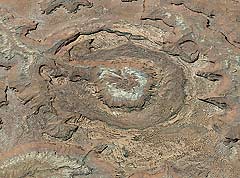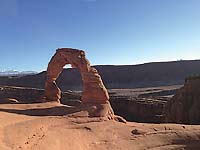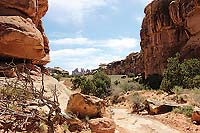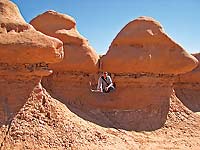Moab is located in the heart of the Colorado Plateau--one of the most scenic places and geologically significant on Earth. In addition to being a destination for people from all around the globe who travel here to hike, bike and vacation, Moab is a magnet for geoscientists. I first traveled to Moab more than 30 years ago with geology field camp as a college student from North Carolina.
There is a common saying among geologists that the best are those who have seen the most geology in the field. Moab offers a broad spectrum of geology in one of the world’s most scenically splendid tableaus.
 |
| Upheaval Dome, Google Earth view |
In the last 15 years or so, since the publication of 1,000 Places to See Before You Die by Patricia Schultz, the idea of a life, or bucket, list has really taken hold, especially among travelers. The idea of a geologist’s bucket list is a bit older, going back to a 1990 column by Lisa Rossbacher in a trade magazine. While her original column is hard to find anymore, various versions of it or similar lists are available online.
Rossbacher’s list made a large impact on me as an enthusiastic young student. As I set out to make the world my classroom, I quickly learned that it was far better to visit these places in person than to view them as slides shown in a classroom while a professor rambled on lovingly describing rocks.
A geologist’s life list contains both generic and specific features and sites. Generic features represent significant geologic principles or processes, such as an erupting volcano, a limestone cave, or a fossil trilobite. Specific sites are superlative or “textbook” examples of the results of these processes that are important in the history of the science or the planet. Specific sites are archetypes or are especially scenic, such as Mount St. Helens and the Great Barrier Reef.
 |
| Delicate Arch |
Since geology is the study of the Earth, geosites are found across the globe from the South Pole to the Arctic Circle. I believe that the most striking thing about the original list, or nearly any list of top geologic sites, is the number of them found on the Colorado Plateau. (See the March issue of Geology Happenings online at www.moabhappenings.com to learn more about the Colorado Plateau.)
The original geologist’s life list contained only eleven locales in North America, but nearly half of them are found within a few hundred miles of Moab. Grand Canyon, of course, tops the bucket list for almost any group of people, including geologists. Meteor Crater in Arizona reveals what happens when a good-sized rock from space slams into our planet, the Goosenecks of the San Juan are incised river meanders looping nearly back upon themselves, the Waterpocket Fold (in Capitol Reef National Park) is a massive fold in the earth’s rock layers, and Shiprock, New Mexico represents what is left of a volcano after everything but the vent or conduit has eroded away.
I here present a Moab edition of a geologist’s life list, with confidence that this list isn’t enticing to only geologists. The incredible exposure of the rock record in the Moab area, with its fossils, mesas, buttes, cliffs and canyons, and the red rock desert and high mountains speaks to a much larger audience.
Delicate Arch. To see the most iconic natural arch in the world.
 |
| The Grabens |
Fisher Towers. To understand what geologists mean when they say “red bed.”
Upheaval Dome. To view this enigmatic site that demonstrates that there is still much that we do not know or understand about the history of our planet.
Dead Horse Point. To embrace the full tableau of canyon country geology from the La Sal Mountains to the Colorado River below.
The Grabens. To witness one result of the movement of salt underground and to see what more geologists come to southeastern Utah to study than any other single site (see the June issue of Geology Happenings to learn more).
La Sal Mountains. To experience igneous rocks, in contrast to the sedimentary layers of the red rock desert.
 |
| Goblin Valley. Photo by James St. John |
Goblin Valley. To enjoy the fantastical shapes carved from rapidly eroding soft rocks.
Book Cliffs. To survey the Mancos Shale, which was deposited in the Western Interior Seaway when shallow seas stretched from Utah almost to Iowa late in the time of the dinosaurs.
Landscape Arch. To appreciate a thin, very old arch that one day may provide additional evidence of geologic change on a human time scale.
Moab also has plenty of generic features that should be on any geo-bucket list: a pothole in slickrock full of water (and ideally fairy shrimp), a slot canyon, a flash flood shaking the ground while filling a normally-dry wash, a hanging garden, petrified wood. Some are ephemeral, while others will persist beyond human history. Perhaps the most thrilling examples are the dinosaur footprints found all around Moab, including the Mill Canyon Tracksite.
Moab doesn’t offer everything to a geoscientist. For example, we lack glaciers, geysers and coastlines. But if I had to choose a geosite in which to live, I would choose Moab (and I did). And if I had to choose a place where I could share the wonders of geology with others, again I would choose Moab. Thank you for joining me as we continue to explore Moab each month in Geology Happenings.




